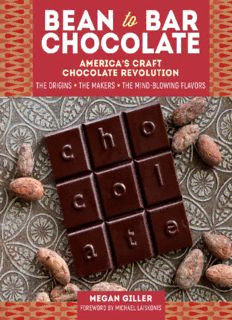
Bean-to-Bar Chocolate: America’s Craft Chocolate Revolution: The Origins, the Makers, and the Mind-Blowing Flavors PDF
Preview Bean-to-Bar Chocolate: America’s Craft Chocolate Revolution: The Origins, the Makers, and the Mind-Blowing Flavors
To Marcus Contents Foreword Introduction About the Recipes in This Book Chapter One: From The Bean Water-Based Drinking Chocolate Cocoa Tea Cocoa Nib Ice Cream Chapter Two: A Sense of Place Single-Origin Dark Chocolate Truffles Grown-Up Peanut Butter and Jelly Truffles Single-Origin Brownie Flight Champurrado Drinking Chocolate Chapter Three: Tasting and Eating Mayan Chocolate Mousse Ceylon Tea Fudge Sauce Burnt Caramel–Amaro Truffles Honey-Carrot Purée Chapter Four: Chocolate Snobs Don’t Eat Milk Chocolate (and other myths, debunked) Olive Oil–Sourdough Truffles White Chocolate–Hazelnut Mousse in Pineapple Cups Chapter Five: Labeling and the Art of Design Balsamic Strawberries in Mini Chocolate Cups Iced Spicy Drinking Chocolate Truffle Torte Chapter Six: Ethics for the Next Century Devil Dogs Chocolate and Churros Budino di Cioccolato Chapter Seven: The Future of Chocolate Chocolate Sorbet Pop Rocks Chocolate Bark Triple Chocolate Chunk Cookies Epilogue: Chocolate Revolution Appendix The Historey of the World...in Chocolate My Top 50 Bean-to-Bar Makers in the United States Farms, Co-Ops, and Companies Glossary of Chocolate Words Selected Bibliography Thanks Index Additional Photography Treat Your Taste Buds with More Books from Storey Copyright Share Your Experience! F O R E W O R D By Michael Laiskonis, Creative Director, Institute of Culinary Education MAKING CHOCOLATE IS EASY. Making good chocolate is extremely difficult. Most chocolate makers I know share this sentiment to some degree. While a bar of chocolate is indeed the sum of its ingredients and its manufacturing steps, the art and science of crafting that bar also rely on a subtractive process, much like a sculptor liberating beauty from an uncarved block. The chocolate maker starts with an unroasted cocoa bean — an edible diamond in-the-rough — paring away the superfluous to reveal its essential nature. The resulting flavors are an expression of the bean’s time, place, and heritage, and even a bit of the maker’s personality. Compounding this already complex task is the skill needed to preserve the taste of the bean — its bitter edges intact — and then steer the process toward showing that bean’s potential. It’s a skill that relies on experience, endless testing and tasting, and some intuition. The more I learn about chocolate, the more I realize how much I don’t know, which is both wonderfully satisfying and endlessly frustrating. Alas, the word craft itself implies an endless pursuit of elusive perfection. This is the driving force behind craft chocolate, and this book is the first attempt at chronicling this movement in real time. With a connoisseur’s obsession and an investigator’s precision, Megan Giller has created a road map for chocolate lovers to better navigate this brave new world of small-scale producers, their processes, and the delicious diversity of their products. Megan’s own story is like many others — a happenstance tasting bore a life- changing revelation: not all chocolate is the same. It can be different. What separates craft chocolate from the industrial goes far beyond mere aesthetics and into the philosophical. Craft chocolate embraces the variability of an agricultural product that has subtle differences from one origin to the next, and from harvest to harvest. Each batch — each bar — embodies the cocoa bean’s individuality. As we consumers seek to broaden our palates with the flavors of fine chocolate, we also care deeply about where it’s from, what’s in it, and how it’s made. Insight, which this book offers in great depth, enhances the tasting experience. Ethical sourcing and transparency of the process, too, are increasingly important. One might argue that this homegrown movement and its followers are
Description: